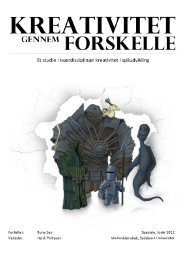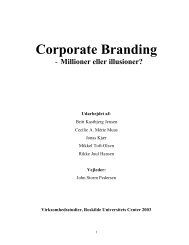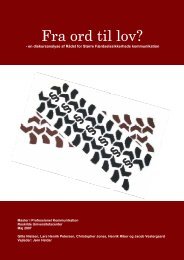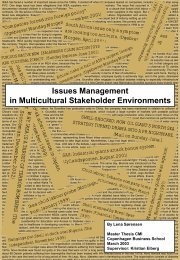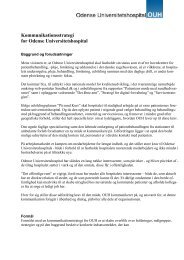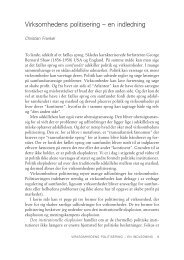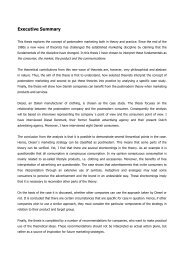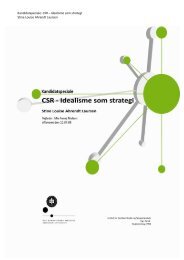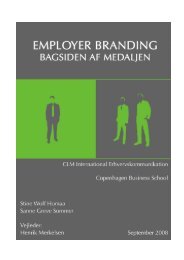- Page 1 and 2:
DET HUMANISTISKE FAKULTET KØBENHAV
- Page 3:
Brian L. Due DEN SOCIALE KONSTRUKTI
- Page 7 and 8:
Indhold !"#$%&$'()*+,-.)/+($0000000
- Page 9 and 10:
BC>)*=D)$00000000000000000000000000
- Page 11 and 12:
!"#$%&$'()*+,-.)/+($ LBM'73K$%&$B?N
- Page 13 and 14:
Chris fremsætter en idé om at de
- Page 15 and 16:
Lehmann-Willenbrock 2012). Hvad der
- Page 17 and 18:
(01) (Vi skal have et katalog …)
- Page 19 and 20:
Induktivt sluttet er disse beskrive
- Page 21 and 22:
Som i eksemplet der blev vist før:
- Page 23 and 24:
multimodale, fordi de kan optræde
- Page 25 and 26:
Pomerantz & Fehr 1997; Huisman 2001
- Page 27 and 28:
LBM'73K$2&$M+>/)/+("*/(
- Page 29 and 30:
Som det ses af modellen, opereres d
- Page 31 and 32:
group theori "$ . Disse inkluderes
- Page 33 and 34:
20%$!")$?-(.)/+("##"$5"*>5".)/;$ De
- Page 35 and 36:
miljømæssige og kognitive aspekte
- Page 37 and 38:
kortfattede og formaterne berøres
- Page 39 and 40:
artifact” (2008:142); og at nye i
- Page 41 and 42:
hvordan deltagere viser affiliation
- Page 43 and 44:
90%$QS,")$)"+*")/>.$C"
- Page 45 and 46:
En deltager er en deltager i kraft
- Page 47 and 48:
perspektiv er her de til tider klar
- Page 49 and 50:
!"#$2$&$345/*/$6$7"+*/$$ $ LBM'73K$
- Page 51 and 52:
I forhold til besvarelse af afhandl
- Page 53 and 54:
Første møde: 01.04.09 kl. 10.30-1
- Page 55 and 56:
mikroanalytiske undersøgelsesdesig
- Page 57 and 58:
end hvad de gør, 3) forskeren væl
- Page 59 and 60:
er robuste. Efterhånden som situat
- Page 61 and 62:
kommunikationshandlingerne skabes a
- Page 63 and 64:
I afhandlingen bruges disse symbole
- Page 65 and 66:
Det første eksempel viser hvordan
- Page 67 and 68:
LBM'73K$1&$!"($)"+*")/>."$5+>/)/+($
- Page 69 and 70:
implicitte ”regler” for samvær
- Page 71 and 72:
til den efterfølgende TCU eller ta
- Page 73 and 74:
Medlemskab af kategorier er tilskre
- Page 75 and 76:
Levinson 1987). Ifølge Brown & Lev
- Page 77 and 78:
• Idéen om at tænkning er krops
- Page 79 and 80:
modaliteter der må tages højde fo
- Page 81 and 82:
ikke forveksle med Chicago-skolens
- Page 83 and 84:
LBM'73K$E&$!"($=(=#R>">)*=)"."$)/#
- Page 85 and 86:
tale om talehandlinger ud fra en id
- Page 87 and 88:
Hvad vi kan vide om verden, går ik
- Page 89 and 90:
egrænsninger for dets brug. Men ti
- Page 91 and 92:
1. Kritik som respons på en fremsa
- Page 93 and 94:
LBM'73K$J&$B(=#R>"$=?$N+;",".>"45"#
- Page 95 and 96:
Anton peger på lærred (set fra mo
- Page 97 and 98:
! @*!&,?3,&!3#$!1/-.7!#!37*-,2!*$!.
- Page 99 and 100:
27 we can sa:y that but (.) eh (0.5
- Page 101 and 102:
827*2!1*-+,&!/&5,2!%+!*$!$,&!1=?
- Page 103 and 104:
Anton siger: ”i guess (.) after t
- Page 105 and 106:
Anton producerer ytringen ved hjæl
- Page 107 and 108:
Antons uddybende forklaring lyder:!
- Page 109 and 110:
Anslagspunktet for håndbevægelsen
- Page 111 and 112:
Bo peger på dokumentet der ligger
- Page 113 and 114:
Bos kommunikationshandlinger. Anton
- Page 115 and 116:
væk fra den problematiske kritik.
- Page 117 and 118:
LBM'73K$@&$B(=#R>"$=?$N+;",".>"45"#
- Page 119 and 120:
18 om de egentlig os ku tænke sig
- Page 121 and 122:
Eksemplet viser blandt andet hvorda
- Page 123 and 124:
nu blot uden den ironiske markering
- Page 125 and 126:
Sara italesætter ikke direkte de a
- Page 127 and 128:
@09$B(=#R>"T$,"#$9&$OZ(,)"*/(
- Page 129 and 130:
Sara inviterer med den kropslige ma
- Page 131 and 132:
idéfremsætteren producerer en yde
- Page 133 and 134:
på. Det er altså designet af resp
- Page 135 and 136:
%F0%$A",-.)/+($=?$5+)"()/"##"$=(>/H
- Page 137 and 138:
(05) (Luderpresse …) (1. møde, o
- Page 139 and 140:
ekspliciteret pointe. For at udrett
- Page 141 and 142:
Thors fastholdelse af taleretten sk
- Page 143 and 144:
LBM'73K$ %%&$ M*+,-.)/+("($ +$;/=$;
- Page 145 and 146:
Idéen er ikke blot fremsat af en u
- Page 147 and 148:
Det er en måde at sige og gøre no
- Page 149 and 150:
på det institutionelle formål og
- Page 151 and 152:
”In certain conditions, left to s
- Page 153 and 154:
afhandling på at ” (…) more re
- Page 155 and 156:
liver bedre (jf. Girotra 2010). Det
- Page 157 and 158:
LBM'73K$%2&$B(=#R>"$=?$N+;",".>"45"
- Page 159 and 160:
10 simpelthen gribe syv ud af tredv
- Page 161 and 162:
32 Bent: ja 33 Kim: ˆja det er et
- Page 163 and 164:
Umiddelbart efter peger Dan på Kim
- Page 165 and 166:
Den følgende analyse af eksemplet
- Page 167 and 168:
Ytringen kan nok ses som en konkret
- Page 169 and 170:
Kim holder sit fokus på hvordan or
- Page 171 and 172:
%201$G*-,$4",$IH>5=D">$>R44")*/>."$
- Page 173 and 174:
Denne kobling mellem politikerne (
- Page 175 and 176:
%20J$Q-#)/4+,=#"$=??/#/=)/+(>4=*.S*
- Page 177 and 178:
organiseret distribueret kognition
- Page 179 and 180:
1. Hans Skov får fire gymnasieelev
- Page 181 and 182:
Som eksemplet har vist, er idéudvi
- Page 183 and 184:
(9) Ligesom en æske … (1. møde,
- Page 185 and 186:
18 så det ku godt væ:re at jeg ku
- Page 187 and 188:
fingeren op” mens han simultant p
- Page 189 and 190:
Inden for neurovidenskaben har man
- Page 191 and 192:
placering i det materielle omgivend
- Page 193 and 194:
(11) Den sorte farve… 2. møde, o
- Page 195 and 196:
! 11 Viggo: °det vil være [ovenp
- Page 197 and 198:
Fra dette tidspunkt i samtalen flyt
- Page 199 and 200:
levet socialt distribueret. Brugen
- Page 201 and 202:
Idet Yrsa i linje 1 ytrer et forsla
- Page 203 and 204:
samtalen (jf. Button 1987) og for e
- Page 205 and 206:
!! (14) (Noget af det jeg tænker)
- Page 207 and 208:
Fremsættelsen af idéen udfolder s
- Page 209 and 210:
LBM'73K$%8&$!/>)*/C-"*","$*">>+-*D"
- Page 211 and 212:
tegne kasser i luften eller at lukk
- Page 213 and 214:
Funktionen af de nonverbale ressour
- Page 215 and 216:
Koestler forklarer videre at bisoci
- Page 217 and 218:
I direkte forlængelse af at latter
- Page 219 and 220:
%808$L+(.#->/+($+/>)"*"(,"$?+*>.(/(
- Page 221 and 222:
!"#$1&$',:-,;/.#/(
- Page 223 and 224:
% LBM'73K$%1&$L+(.#->/+($$ Det er b
- Page 225 and 226:
• Aktivering af de multimodale re
- Page 227 and 228:
Eks. (1) Idéen fremsættes som et
- Page 229 and 230:
Samlet set kan spørgsmålet som fr
- Page 231 and 232:
subjektive plan. Idéen forbliver i
- Page 233 and 234:
Eks. (14) Idéen tager sit udgangsp
- Page 235 and 236:
man argumentationsteknikken for et
- Page 237 and 238:
Eks. 3 19 Sara: nogle! penge indime
- Page 239 and 240:
ansigts-truende handlinger; hvilket
- Page 241 and 242:
Eks. 3 Kritikken håndteres ved at
- Page 243 and 244:
Eks. 9 Der sker en kropslig spejlin
- Page 245 and 246:
Respons kan blive givet på en skal
- Page 247 and 248:
være til stede som deltager under
- Page 249 and 250:
nihilo (jf. Sapir 1924). Igennem an
- Page 251 and 252:
LBM'73K$%J&$["#;.*/)/.$$ Afhandling
- Page 253 and 254:
Taget i sin fulde konsekvens er bå
- Page 255 and 256:
Figur 13. Et begrebskompleks for si
- Page 257 and 258:
Figur 14: Oversigt over et udsnit a
- Page 259 and 260:
Modellens epistemologi: Viden udgø
- Page 261 and 262:
Det beskrives i mykologien (svampel
- Page 263 and 264:
$ %@08$`*"4)/,/.(/(
- Page 265 and 266:
Endelig fremanalyseres det hvilke s
- Page 267 and 268:
• How the use of different semiot
- Page 269 and 270: KEY NOTES, PAPERS AND PRESENTATIONS
- Page 271 and 272: Kjeld er kommunikationsdirektøren
- Page 273 and 274: Han strækker tre fingre 12 (2.5) H
- Page 275 and 276: løbende korrigerende kommunikation
- Page 277 and 278: Figurer: Figur 1: Model over afhand
- Page 279 and 280: Arminen, Ilkka. 2005. Institutional
- Page 281 and 282: Bennington, Ashley J., Judy C. Shel
- Page 283 and 284: Christensen, Clayton. 2008. The Inn
- Page 285 and 286: Action: Studies in Conversation Ana
- Page 287 and 288: Edwards, Betty 1986. Drawing on the
- Page 289 and 290: Finke, Ronald. 1990. Creative image
- Page 291 and 292: Gibson, J.J. 1977. The Theory of Af
- Page 293 and 294: Gravengaard, Gitte & Lene Rimestad.
- Page 295 and 296: Heritage, John. 1989. Current Devel
- Page 297 and 298: Hutchins, Edwin. 1990. The technolo
- Page 299 and 300: Kaufman, A., S. Kornilov, A. Bristo
- Page 301 and 302: Labov, W. & J. Waletzky. 1967. Narr
- Page 303 and 304: Magnusson, Peter R. 2009. Exploring
- Page 305 and 306: Mondada, Lorenza. 2007a. Multimodal
- Page 307 and 308: Nonaka, Ikujiro & Hirotaka Takeuchi
- Page 309 and 310: Pomerantz, Anita. 1984a. Agreeing a
- Page 311 and 312: Sacks, Harvey L. 1987. On the Prefe
- Page 313 and 314: Schegloff, Emmanuel A. 1988. "On a
- Page 315 and 316: Sellars, W., Richard Rorty & R. Bra
- Page 317 and 318: Stivers, Tanya & F. Rossano. 2010.
- Page 319: Thompson, Leigh L. & Hoon-Seok Choi




